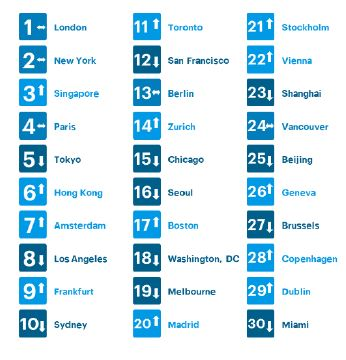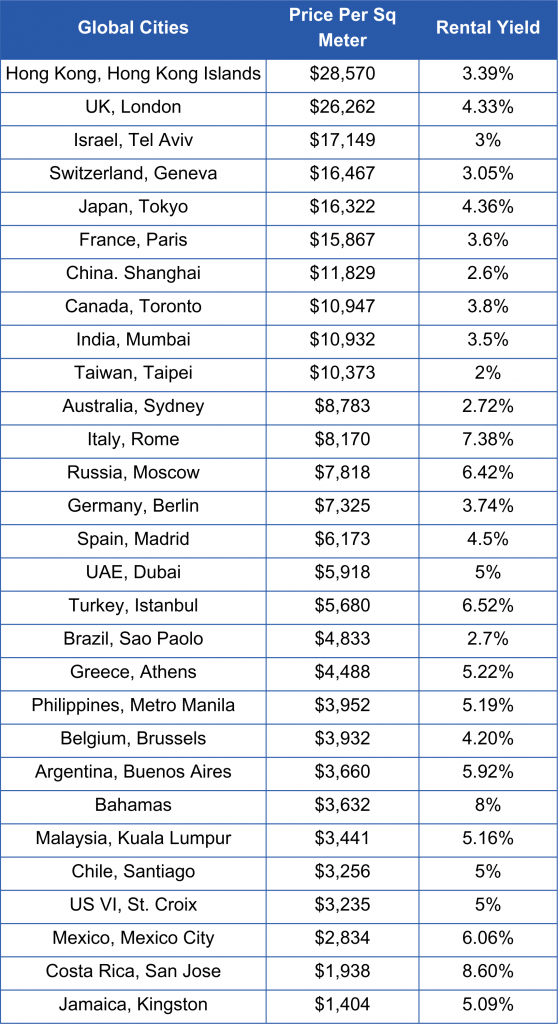Contenuto globale: analisi dei mercati immobiliari a livello globale
Obiettivi di apprendimento della lezione:
- Understand the impact of economic conditions on real estate markets worldwide, focusing on how GDP growth, inflation, and economic stability influence property values and investment potential.
- Evaluate market demand and supply to identify imbalances that affect real estate prices and opportunities in high-demand urban areas versus overbuilt markets.
- Examine foreign investment policies and their impact on global real estate markets, understanding how regulations in countries like New Zealand and Canada influence foreign investment flows.
- Analyze the role of infrastructure and development projects in enhancing property values, particularly in cities undergoing significant urban development.
A. Analyzing Real Estate Markets Globally
Analyzing global real estate markets requires a broader understanding of economic conditions, market trends, and government regulations. Key factors to consider include:
- Economic Conditions
The global economy significantly influences real estate markets. For example, China’s economic growth has driven real estate prices in cities like Shanghai E Beijing, while economic challenges in countries like Argentina have led to depreciating property values. Investors must analyze macroeconomic trends such as GDP growth, inflation, and unemployment to understand how they impact local real estate markets. - Market Demand and Supply
Demand and supply imbalances are a critical component of real estate analysis. Cities like New York E Tokyo often experience high demand and limited supply, driving up property prices. On the other hand, regions with overbuilt markets, such as Dubai, may face slower growth due to an excess supply of real estate. - Foreign Investment Policies
Many countries regulate foreign investment in real estate. For example, Nuova Zelanda has imposed restrictions on non-resident buyers to curb rising property prices, while Canada has introduced higher taxes on foreign buyers in certain markets. These policies can significantly affect the demand for real estate from international investors. - Infrastructure and Development Projects
Global cities undergoing major infrastructure upgrades, such as new public transit systems or airport expansions, often see property values rise. For example, Sydney’s infrastructure projects have spurred demand in surrounding areas, creating new investment opportunities.
Figura: Top 30 Global Real Estate Market Rankings
Descrizione:
This table ranks the top 30 global real estate markets, showcasing major cities by their real estate attractiveness. London retains the top spot, followed by New York E Singapore, highlighting these cities’ dominance in global real estate. Other cities like Tokyo, Hong Kong, and Paris also rank highly, reflecting their economic and property market strength. The list further includes cities from Europe, North America, and Asia, demonstrating a wide geographic distribution of real estate hotspots.
Punti chiave:
- London remains the top real estate market, reinforcing its position as a global economic and cultural hub.
- New York and Singapore follow closely, reflecting their significant roles in global finance and investment.
- European cities like Paris, Amsterdam, and Frankfurt are well-represented, showcasing their appeal for both commercial and residential investments.
- Emerging markets like Shanghai, Beijing, and Toronto feature in the top 30, highlighting their growing influence in the global real estate landscape.
- The rankings underscore the importance of economic strength, livability, and investment attractiveness in determining real estate market positions.
Application of Information:
This data is crucial for real estate investors, analysts, and policymakers to identify the most attractive markets for investment or development. Investors can use these rankings to focus on cities with high demand and growth potential, while learners can understand the factors driving global real estate trends and rankings.
B. Analyzing a Real Estate Investment Globally
When analyzing a real estate investment on a global scale, investors must focus on market-specific factors, financial analysis, and geopolitical conditions:
- Property Location
Location remains a key factor globally. For example, in Hong Kong, properties in Central O Tsim Sha Tsui command higher prices and returns due to proximity to business hubs. Similarly, in New York, properties in Manhattan outperform those in outer boroughs in terms of rental income and appreciation potential. - Rental Yield and Return on Investment (ROI)
Rental yields vary widely across global markets. In Singapore, rental yields are often lower (around 2-3%), reflecting the high cost of property. In contrast, markets like Mexico City O Bangalore may offer higher yields, typically ranging from 5-8%, but come with additional risk factors like economic instability or legal complexity. - Capital Appreciation Potential
Investors must consider capital appreciation potential based on local market trends and economic forecasts. For example, properties in San Francisco have appreciated rapidly due to the tech boom, while slower-growth cities like Milan may offer more modest appreciation but better long-term stability. - Property Management and Maintenance Costs
Global real estate investments often come with added complexities related to property management, particularly for foreign investors. In countries like Brasile O Sudafrica, investors may face higher maintenance costs due to infrastructure challenges. Additionally, managing properties from abroad often requires hiring local property managers, which adds to overall expenses. - Legal and Tax Considerations
Tax laws for real estate investments differ by country. In the United States, foreign investors may be subject to Foreign Investment in Real Property Tax Act (FIRPTA) regulations, while Australia imposes stamp duty E land taxes on foreign buyers. Investors must be aware of legal requirements and tax implications before committing to international real estate deals.
Figura: Global Real Estate Price and Rental Yield Comparison
Descrizione:
This table compares real estate prices per square meter E rental yields across major global cities. Hong Kong leads with the highest property price at $28,570 per square meter, but a relatively low rental yield of 3.39%. Conversely, cities like Italy, Rome E Turkey, Istanbul offer high rental yields at 7.38% and 6.52%, respectively, paired with more affordable property prices. The data highlights significant global disparities in real estate affordability and investment returns, with cities like Mexico City being the most affordable, and Bahamas offering the highest rental yield at 8%.
Punti chiave:
- Hong Kong and London have the highest real estate prices but relatively low rental yields, indicating higher entry costs with limited returns.
- Bahamas (8%) E Istanbul (6.52%) offer some of the highest rental yields, making them attractive for income-focused investors.
- Cities in Europe (e.g., Rome, Athens, and Berlin) show a balance of affordability and solid rental returns, with yields exceeding 4%.
- Emerging markets like Metro Manila (5.19%) E Buenos Aires (5.92%) provide strong rental yields, reflecting potential for investment growth.
- The data highlights trade-offs between high property prices and yields, enabling investors to tailor their strategies based on their goals.
Application of Information:
This data is valuable for real estate investors and analysts to identify cities with high rental returns or long-term appreciation potential. High-yield cities like Bahamas and Istanbul are ideal for income generation, while cities like Hong Kong and London may appeal to those seeking stable, high-value investments. Learners can use the table to understand how property prices and rental yields influence real estate strategies globally.
Conclusion (Global)
Analyzing global real estate markets and specific property investments requires a comprehensive understanding of local economic conditions, market demand, and financial factors. By considering property location, rental yield, capital appreciation potential, and legal considerations, investors can make informed decisions in both established and emerging markets worldwide.
Informazioni chiave sulla lezione:
- Economic stability and growth are pivotal, with strong economies typically showing robust real estate markets, whereas regions with economic challenges may see stagnant or declining property values.
- Demand and supply dynamics are crucial, with cities like New York and Tokyo experiencing high demand and price increases due to limited supply, while other areas may have excess supply that dampens growth.
- Foreign investment policies can significantly affect market dynamics; restrictive policies might protect local markets but can also limit investment opportunities.
- Infrastructure developments often lead to increased property values, making nearby real estate more attractive for both commercial and residential investments.
Dichiarazione di chiusura:
Effective analysis of global real estate markets requires a comprehensive understanding of both macroeconomic indicators and localized market conditions. This approach enables investors to identify areas with high growth potential and navigate the complexities of international real estate investments.



